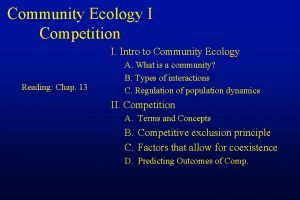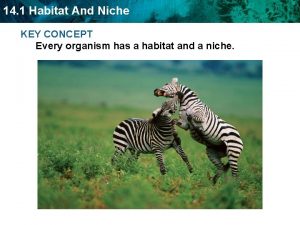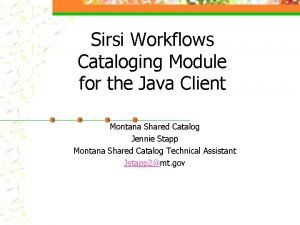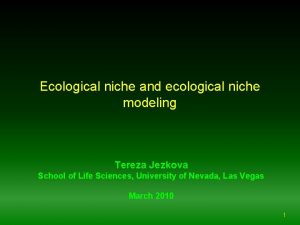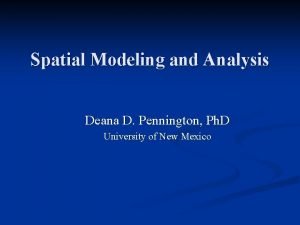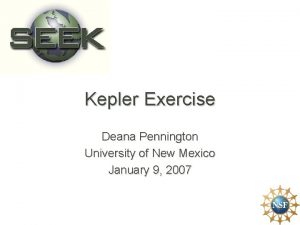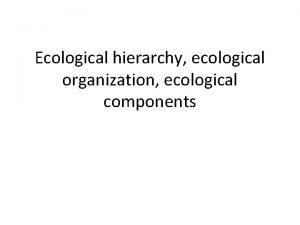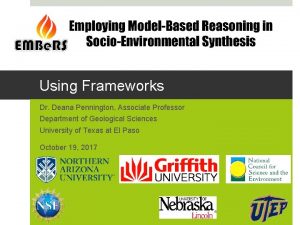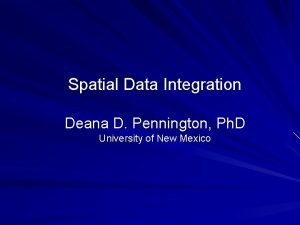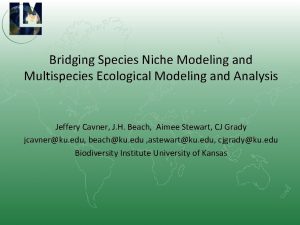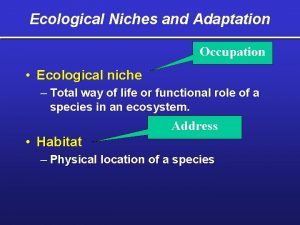Ecological Niche Modeling Conceptual Workflows Deana Pennington University

















- Slides: 17

Ecological Niche Modeling Conceptual Workflows Deana Pennington University of New Mexico December 16, 2004

Wed/Thursday Wed morning: Kepler training p Wed afternoon: Workflows that can be slightly modified from the mammal/climate change workflow (community + help from SEEK) p Thurs: Workflows that require substantive new functionality p

User list p Kepler-project. org ->Getting involved ->kepler-users mailing list

Usability p Survey and consent forms http: //www. surveymonkey. com/s. asp? u=90778724262

Community projects p Workflows that could be done with minor modification to the mammal/climate change workflow

Variations on CC theme Paleoclimates p Analysis for all species, undeveloped country p Other places/other species p Different scales p

Re-sampling: bootstrapping and jacknifing Working

Invasive Species

Monitoring



Community/SEEK projects p Workflows that could require substantially different actors

Others Dispersal p Productivity from remotelysensed imagery p ? ? ? p

Macroecology Needed

Stat/process model comparison/calibration

Environmental space

ENM Tasks Detecting species interactions Evaluate impacts on species’ distributions (e. g. , human activities, environmental characteristics, interactions, history, ecology, etc. ) Designing monitoring systems (e. g. , under climate change scenarios) Map genetic diversity onto biogeographic patterns/species distributions/landscape diversity Map biogeographic/phylogeographic patterns across multiple species Time series analyses of species’ distributions; analysis of coupling/decoupling of species’ ecological nichs through time Developing scenarios of invasion and filling a potential distribution Discovery of new species (prediction of) Constrain of potential distributional areas to actual distributional areas Model validation Inference of physiological parameters from distributions or vice versa Evaluate dispersal capabilities Macroecological analysis 1. 2. 3. 4. 5. 6. 7. 8. 9. 10. 11. 12. 13. n n n Predict densities of populations (persistence) Analysis of completeness of data sets (e. g. , inventory completeness) Using known interactions to reconstruct systems (e. g. , diseases) Overlay biotic patterns with human activity (e. g. , land use) 14. 15. 16. 17. n n 18. 19. 20. 21. 22. 23. Conservation prioritization (complementarity, etc. ) Analysis of beta-alpha-gamma diversity, etc. Other manifestations… Single species Multiple species Evaluate utility of environmental surrogacy for representing biodiversity information Classification of biotic domains into a regionalization Evaluation of representativeness and bias in data sets (realm/range of inference) Detection of errors in data sets (quality control for taxonomy and geographic references in data sets ) Model validation Model ecosystems (e. g. , species composition) based on simulated/created data sets to evaluate different techniques
 Deana vrban
Deana vrban Can a realized niche be larger than a fundamental niche
Can a realized niche be larger than a fundamental niche Niche partitioning
Niche partitioning The lion’s ecological niche includes its behavior and
The lion’s ecological niche includes its behavior and What is an ecological niche? *
What is an ecological niche? * Environment vs ecology
Environment vs ecology Habitat vs. niche
Habitat vs. niche Simple definition of niche
Simple definition of niche Disease-specific workflows
Disease-specific workflows Sample jira workflows
Sample jira workflows The unified software development process
The unified software development process Goanywhere advanced workflows
Goanywhere advanced workflows Modern project profiles in spm
Modern project profiles in spm Sirsi workflows
Sirsi workflows Model and role modeling theory
Model and role modeling theory Dimensional modeling vs relational modeling
Dimensional modeling vs relational modeling Paige pennington
Paige pennington Pennington point
Pennington point

